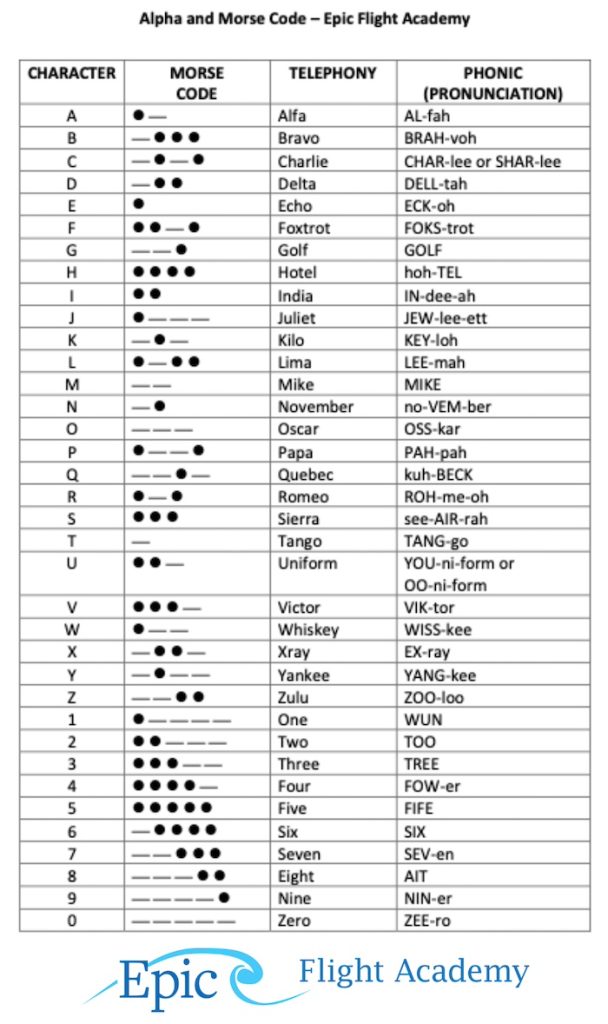
Did you know there is an aviation alphabet? English is the official language for every aviator. Pilots from every airline speak English at every airport. This is why international flight students make learning the language a priority. For the purpose of safety, much of aviation is standardized, including communication. Pilots use the NATO (North Atlantic Treaty Organization) Phonetic Alphabet to communicate.
Pilots never pronounce letters when they are transmitting to Air Traffic Control, and vice-versa. Instead, each letter of the alphabet is assigned a code word to represent the letter. These are easy to memorize, and you will use these terms frequently as a pilot. Pilots often speak in shorthand, or with abbreviations. However, when using the alpha code, they say entire words to represent a single letter.
What does this have to do with flying? It’s all about clear communications. For example, there are even special ways to pronounce numbers.
All pilots, air traffic controllers, and flight dispatchers must know the aviation phonetic alphabet to quickly and accurately relay information. Pilots use the phonetic alphabet to communicate with the nearest flight tower or their destination, ensuring clarity and avoiding miscommunication. The aviation alphabet is represented by the following words:
A – Alfa
B – Bravo
C – Charlie
D – Delta
E – Echo
F – Foxtrot
G – Golf
H – Hotel
I – India
J – Juliet
K – Kilo
L – Lima
M – Mike
N – November
O – Oscar
P – Papa
Q – Quebec
R – Romeo
S – Sierra
T – Tango
U – Uniform
V – Victor
W – Whiskey
X – X-ray
Y – Yankee
Z – Zulu
The aviation phonetic alphabet is widely used and accepted today. It is the standard for anyone learning to become a pilot or working in the air travel industry. Understanding the phonetic words for letters and numbers ensures your communication is clear and accepted globally, no matter where you are traveling.
For example, when communicating over the radio, pilots do not say specific letters or numbers directly. Instead, they use the aviation phonetic alphabet, saying the words associated with each letter. The same applies to numbers; pilots and dispatchers communicate each digit separately to ensure clarity and avoid miscommunication. Instead of identifying a tail number as “N592EP,” a pilot identifies as “November Fiver Niner Two Echo Papa.”
Radio telephony codes emerged with the evolution of radio communications. During the Second World War, the armed forces of Australia, the U.S. and the U.K. needed to communicate during joint operations. Leaders modified the U.S. military’s Joint Army-Navy alphabet for the three countries. They called it the US-UK spelling alphabet. British, American, and Australian troops used it successfully.
However, after World War II, various organizations and linguists worked on other challenges of radio communications. In 1956, NATO modified the code words used by the International Civil Aviation Organization (ICAO). This became the international standard when ICAO and International Telecommunication Union (ITU) accepted it. The words were chosen to be accessible to French, Spanish, and English speakers.
Other names for this alpha code include International Radiotelephony Spelling Alphabet (IRSA) and the ICAO (International Civil Aviation Organization) phonetic alphabet. Also, some call it ITU (International Telecommunication Union) phonetic alphabet. In other words, this alpha code can be referred as the ICAO/ITU/NATO Phonetic Alphabet or International Phonetic Alphabet.
Another alpha code is Morse code. Many people have learned this using a song. Although originally used in radio telegraphy, Morse code is still widely used in aviation. The FAA requires pilots to understand Morse code and to identify aircraft call signs since NDBs and VORs still send their identifying letters via Morse code.

See? Wasn’t that Echo-Alpha-Sierra-Yankee to learn? You can download a printable version to study.